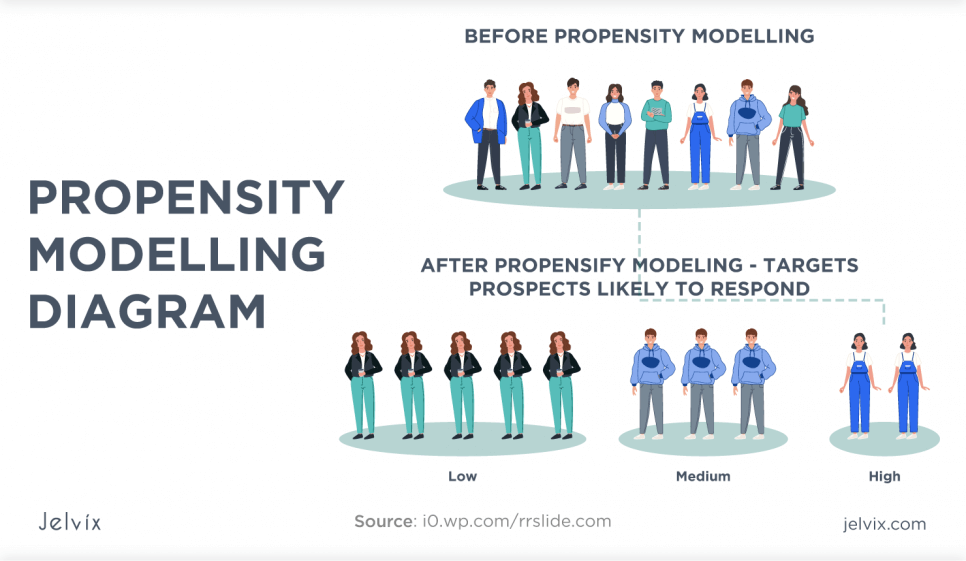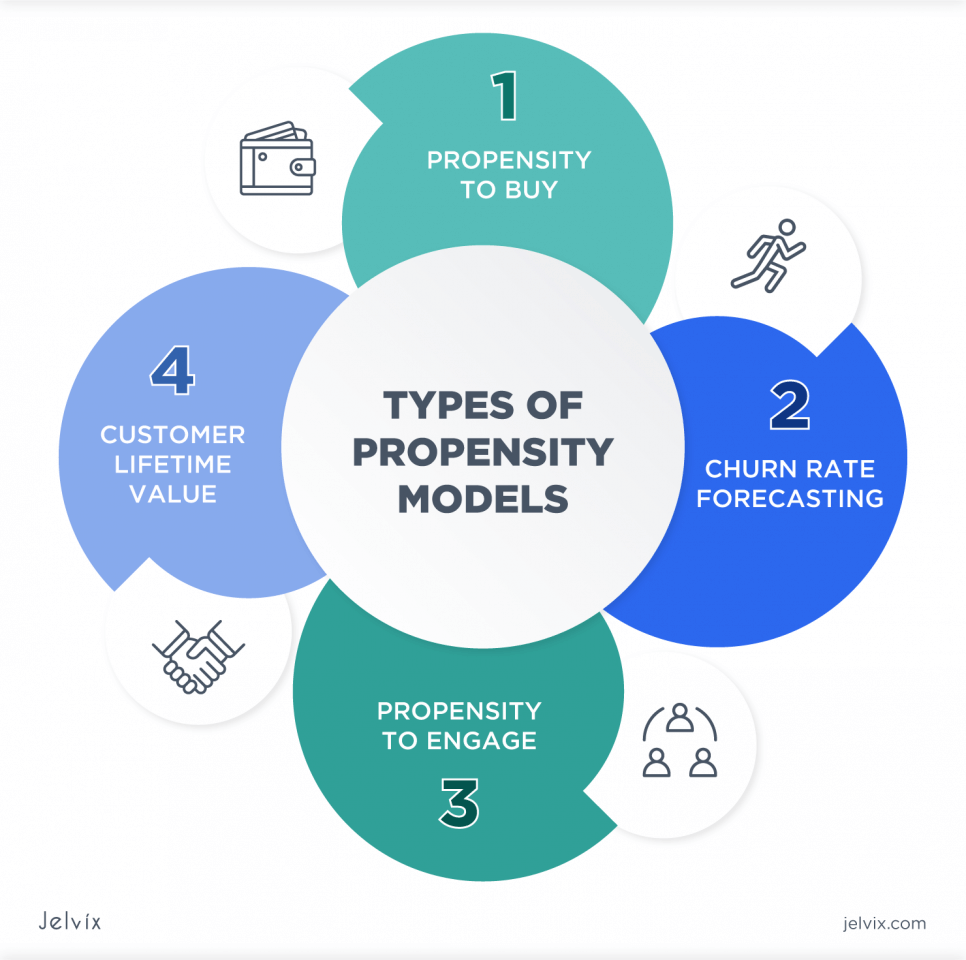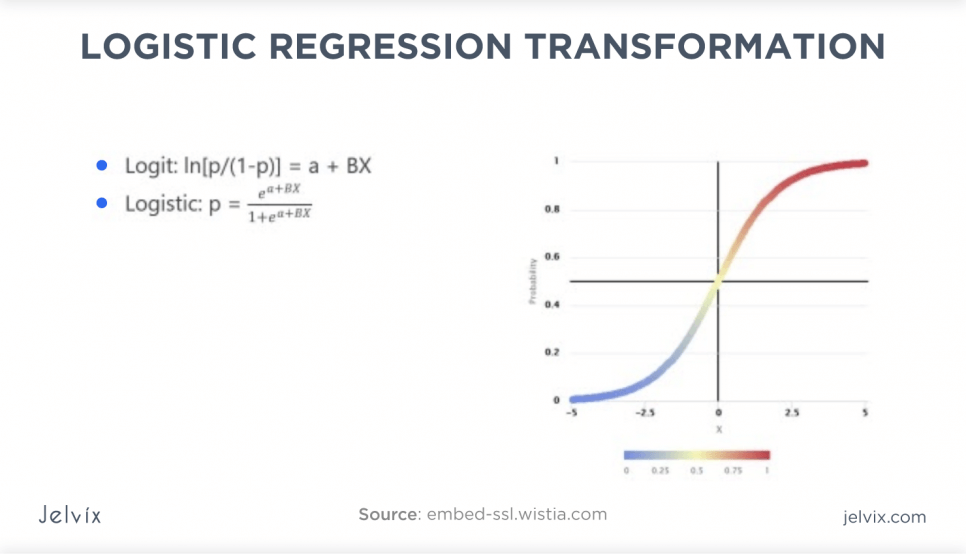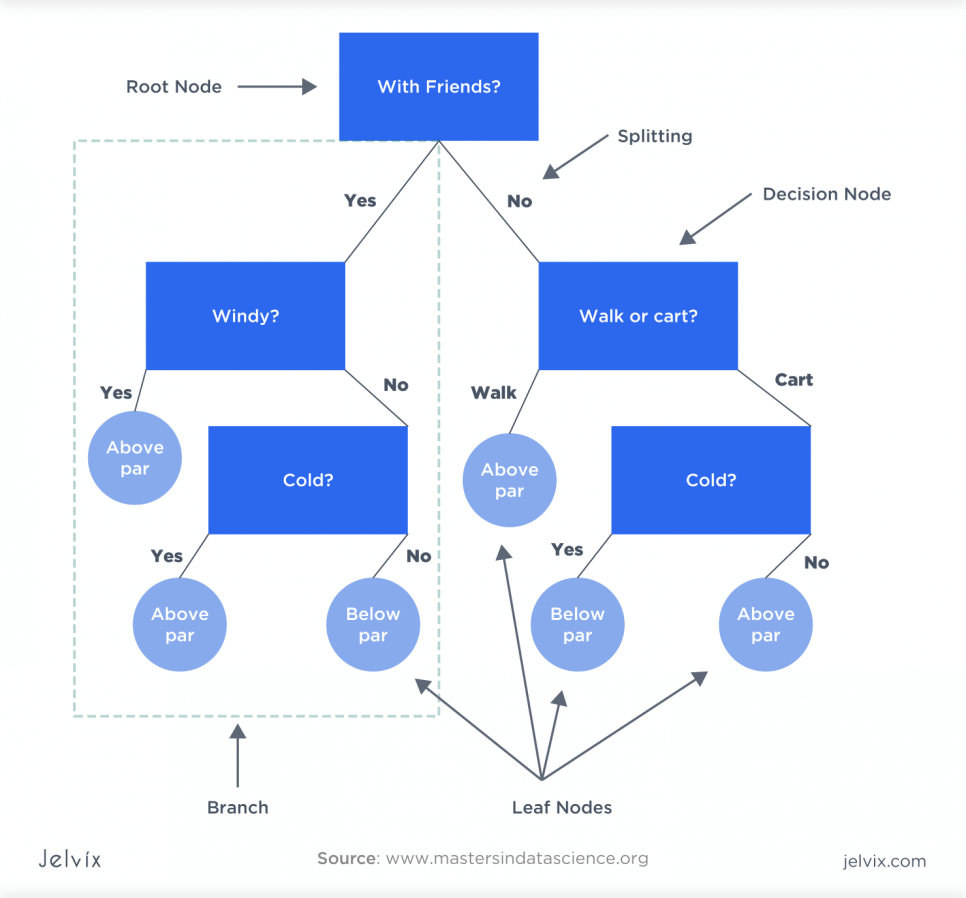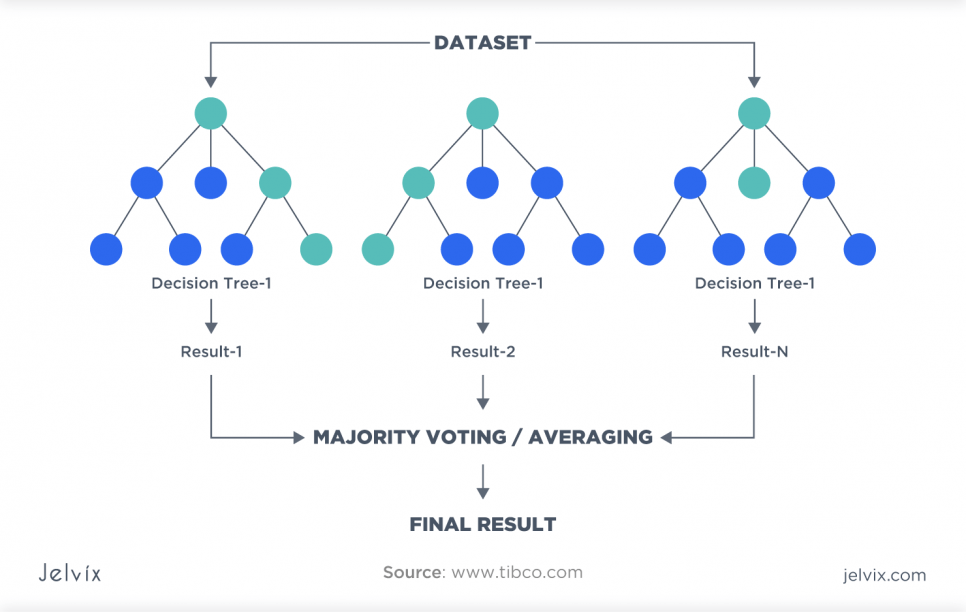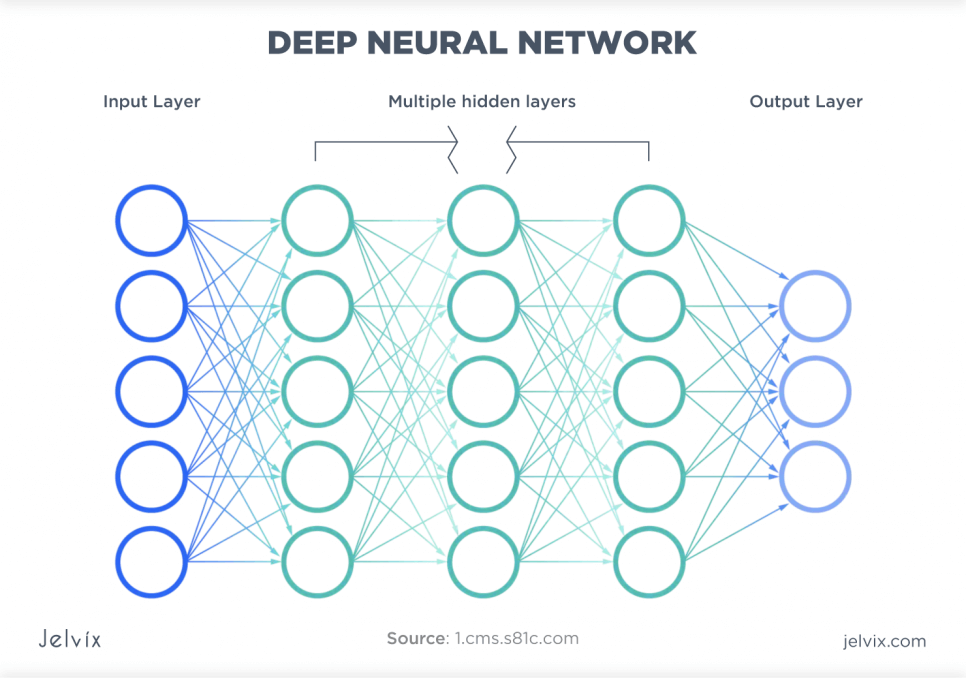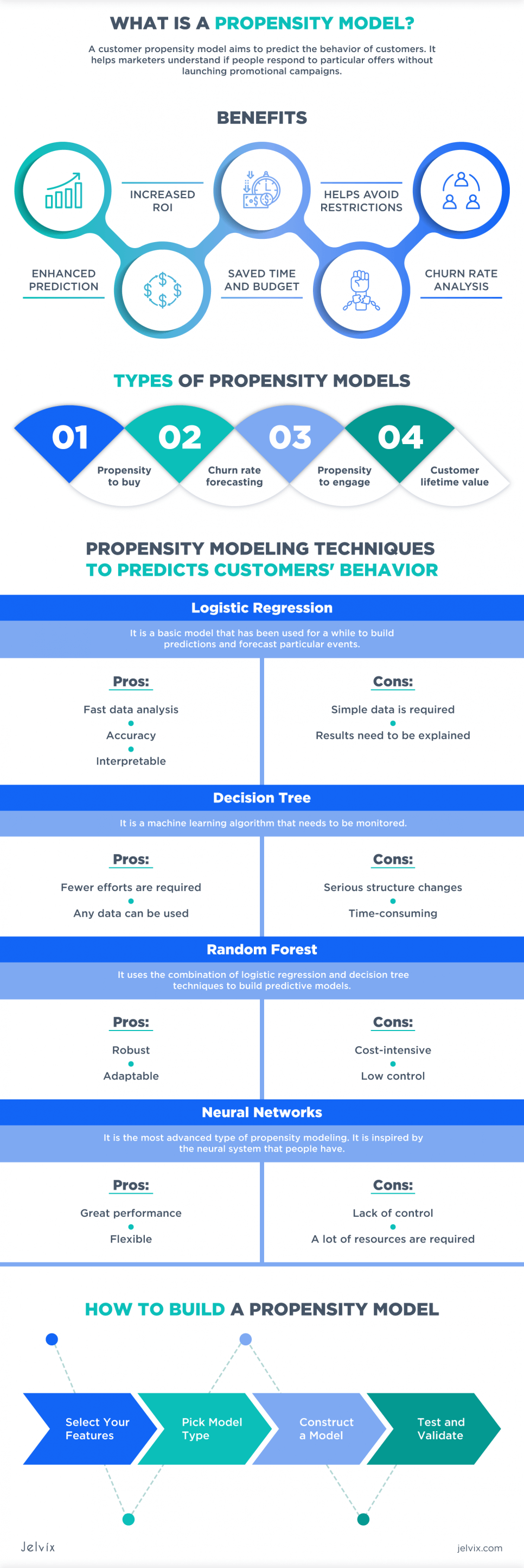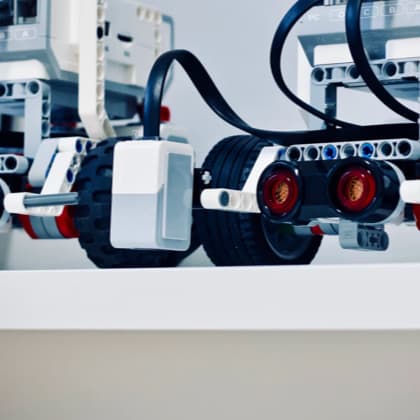Businesses try to forecast the behavior of their customers to understand if customers will buy, share their contact details, etc. Usually, entrepreneurs use their professional experience to build a propensity model. But, machines help improve the job significantly.
For instance, Scandinavian Airlines (SAS) uses machine learning to analyze the behavior of its clients. Thanks to a large amount of data, they offer customized offers to every client separately. It helps the company make a lot of sales, keeping their marketing budget safe.
Thanks to machine learning and artificial intelligence, machines can analyze large amounts of data. Moreover, the technologies help simulate particular events and build accurate predictions.
Down in the post, you will learn more about propensity modeling. Also, you will discover how to craft your propensity to buy models to forecast customers’ behavior.
What Is A Propensity Model?
What does propensity mean? A customer propensity model aims to predict the behavior of customers. It helps marketers understand if people respond to particular offers without the need to launch promotional campaigns. Also, they don’t spend a lot of money on A/B testing. Machine learning helps them understand what outcome they will get, offering a particular product.
The results of forecasting the customers’ behaviors are called propensity scores. They help understand if a particular group of leads will convert into clients or not. According to Wikipedia, lead is a particular form of a customer on the awareness stage. Leads are not ready to make a purchase. Contact information about potential customers is usually considered leads.
Taking into account the fact that the science of estimation isn’t new, you should know that all calculations were made by people for a while. Some of the experts in the niche were able to build helpful forecasts that many companies used. However, the development of computers brought propensity modeling to a new level. It is worth noting that there are different types of propensity models. Nevertheless, all of them have a particular aim – to predict if people of a particular group are likely to do certain actions.
These days, machine learning algorithms help entrepreneurs quickly create detailed pictures of their customers’ behaviors. A top-notch propensity model should be built keeping recent trends in mind to not re-build the propensity to buy model. For example, if new data appears, a model should easily accept and analyze it to keep up with recent trends. Let’s dive deeper and discover how a good propensity model should look.
Factors of A Great Customer Propensity Model
Indeed, the question “What is propensity data modeling?” may not bother you anymore. However, you should know that there is no one-size-fits-all propensity to pay model as a good model should have particular qualities. Down below, we will take a closer look at the factors that define a top-tier customer propensity model that can help achieve success in creating accurate forecasts.
- Dynamic. Since the world evolves constantly, the market also updates quickly. Experts need to invest a lot of time and effort in the development of a model that delivers effective propensity scores. Since we live in a data-rich age, new information is mined constantly. In order to stay current, a good propensity model should be dynamic so that managers will be able to update it quickly.
- High performance. A top-tier propensity to pay model should be capable to analyze large amounts of data fast. If it can deliver effective propensity scores in live time, a company will likely convert leads into new clients who explore a product. Results delivered fast may help marketers make the best offer that will engage a user.
- Scalable. To not build new models from scratch, they need to have a scalable propensity to buy models. Having a scalable model, a company can save a lot of resources by enhancing the current one.
- Demonstrates ROI. Indeed, a simple propensity to pay model can help predict the actions of potential customers, which is a source of helpful insights. However, a top-quality model should estimate the amount of money needed to attract a client and make a sale. It can help calculate the ROI to understand if it will meet particular propensity model marketing goals.
Propensity Modeling Benefits
Insights and customer behavior forecasting are the main benefits of a propensity model to businesses. However, a simplified explanation helps answer the question, “What is a propensity to buy model?”
- Enhanced prediction. When launching promotional campaigns, marketing managers rely on their personal expertise and experience. However, when they develop prediction models, the efficiency of forecasts increases. It happens because all the outcomes are based on mined data. So, the accuracy of predictions increases significantly.
- Increased ROI. Businesses need to conduct a lot of tests to find the best business models that bring the highest revenue. A good model powered by machine learning can analyze a lot of customer attraction tactics. Then, it can bring information about the most effective ones. Consequently, businesses can get the best model for getting the highest ROI.
- Saved time and budget. All companies strive to use their budgets efficiently. Propensity modeling can develop many different tactics and pick the most lucrative one’s lightning fast. Real-world scenario testing may need to invest a lot of time and money. However, machines can do a lot of calculations fast.
- Helps avoid restrictions. Sometimes, businesses may face many issues because it’s forbidden to conduct particular experiments. For example, some tests are banned because they are considered unethical. In such a case, machine learning can analyze the behavior of people based on provided data and build predictive models.
- Churn rate analysis. All businesses pay close attention to the churn rates to avoid revenue losses. When analyzing the predictive behavior of people, businesses get helpful insights. They can define what can boost the churn rate and force people to leave a website without any action. Managers can avoid tactics that may negatively impact them when having a forecast.
Types of Propensity Models
A propensity model is used to predict the behavior. However, it isn’t a one-size-fits-all technique that can be applied to any business. There are different types of propensity models that businesses use to create forecasts. The main differences are caused by the different types of audiences that can be targeted or problems that should be solved. Here are the main types of propensity models:
Propensity to buy. It is the main type of predictive model used by many businesses. They are used to determine the leads who are likely to convert into real clients. A good customer propensity model can help discover the best ways to attract leads and force them to make a purchase. It is very helpful in developing customized offers. They can help enhance marketing techniques and develop the most effective lead magnets.
Churn rate forecasting. Unfortunately, there is no option to convert 100% of attracted leads into customers. This propensity score can help forecast the number of leads who won’t convert. Machine learning can help estimate the worst tactics with high churn rates to avoid.
Propensity to engage. Usually, managers have to conduct many A/B tests to discover which elements will draw users’ attention and drive them to take action. Propensity modeling can help save a lot of time by forecasting the best tactics for engaging users. For example, managers can simply define the best lead magnets, having plenty of data to analyze.
Customer lifetime value. Estimating the maximum amount of money an average customer can bring to build a successful business model is vital. These days, companies need to invest a lot of money into attracting one client, so the customer lifetime value is extremely important. This predictive model can help build a lucrative business model, especially if it is focused on recurring customers.
Propensity Modeling Techniques To Predicts Customers’ Behaviors
What are propensity models in machine learning? Several different machine learning models help get accurate propensity scores. Each model uses particular data analysis tactics to predict customers’ behavior. Moreover, they have specific pros and cons that should be considered before developing your one.
Logistic Regression
It is a basic model that has been used for a while to build predictions and forecast particular events. It has only two variables that are 0s and 1s. They present information on whether an event will happen or not. This technique needs to apply math formulas that may be a bit complex. However, modern-age computers help make calculations fast. The model uses the dependent and independent variables to estimate the possibility of an event occurrence.
Pros:
- Fast data analysis. Thanks to linear algebra, computers can simultaneously apply particular formulas and get results.
- Accuracy. This type of propensity modeling can bring accurate results that aren’t tested in the real world if simple data is used.
- Interpretable. Every particular feature connects with outcomes mathematically. Also, managers can set the significance of features and their effect on outcomes.
Cons:
- Simple data is required. This technique works better with simple and structured data only. Otherwise, the accuracy of results may be reduced.
- Results need to be explained. Since mathematical expressions are used to analyze data, the assistance of experienced mathematicians may be required to describe the results.
Decision Tree
It is a simple technique that is widely used in propensity model marketing. It is a machine learning algorithm that needs to be monitored by managers. It focuses on a predefined target variable. Then, the model divides it by features with the help of nodes, providing Yes/No answers.
In essence, it builds a structure, narrowing down the customer base by applying Yes/No answers to particular questions. For example, it can help find an answer to the question if a customer of a specific age, status, and nationality is likely to renew a purchase.
Pros:
- Fewer efforts are required. It is one of the most hassle-free methods that enables the creation of models with ease. It has an intuitive structure that doesn’t need to be explained in more detail to most customers.
- Any data can be used. There is no need to normalize or scale data to create a decision tree. Also, missing values do not affect the decision tree development.
Cons:
- Serious structure changes. Since a decision tree has a hierarchical structure, lower layers depend on higher ones. Therefore, small changes can affect the entire structure and propensity scores significantly.
- Time-consuming. Managers must invest a sustainable amount of time in training the model.
Random Forest
It is a complicated propensity modeling technique that uses regression and classification to forecast customers’ behaviors. It uses the combination of logistic regression and decision tree techniques to build predictive models. However, the model uses many trees to apply different conditions.
Every tree provides a particular propensity to buy results. The more trees there are, the more results can be obtained. Then, a formula is applied to the received results. It helps increase the accuracy of propensity scores by analyzing different results and picking the most popular ones.
Pros:
- Robust. All the information processes do not have linear relationships. Therefore, minor changes don’t affect the final propensity scores.
- Adaptable. Since decision trees don’t depend on particular data types, the input information can be easily updated. The model will be able to compute new details.
Cons:
- Cost-intensive. The random forest model needs to compute a ton of information. Since the number of trees can be huge, it may be costly to forecast using this model.
- Low control. Users can only control the number of trees and their depth. Other information is generated randomly. Therefore, users have limited control over their customers’ behavior forecasting models.
Neural Networks
It is the most advanced type of propensity modeling that is inspired by the neural system that people have. Neural networks have a layered structure in essence the input and output nodes are the primary layers in the structure. Between them, an undefined number of hidden layers that are interconnected with each other resists.
Neural networks need to be trained. Therefore, their output needs to be tested to ensure that they work correctly in the early development stages. Also, different neural networks can be combined so that the output of one network can be an input for another one.
Pros:
- Great performance. Once a neural network is trained, it can produce a lot of different computations. It’s a great pick for large companies that need to analyze and forecast their clients’ behaviors constantly.
Cons:
- Lack of control. Hidden layers in neural networks cannot be accessed. Their impact on outcomes cannot be estimated as well. Therefore, users have no clue what is happening between the input and output layers.
- A lot of resources are required. Even though training data is provided, managers need to monitor the outputs brought by neural networks. Also, neural networks need a lot of computing power when training.
How To Build a Propensity Model
How do you make a propensity model? If you want to build your propensity to pay model, you need to carry out five major steps. By following them, you will create a forecast which will help you minimize risks and improve your marketing success by analyzing the scope of data only.
- Select Your Features
First, you need to define the features to describe your customers. Features are also known as independent variables. In mere words, they are input data like a customer’s age, place of birth, or income. Only imagination defines the features you can develop. Features need to form particular groups of customers to predict their behaviors accurately.
- Pick Model Type
Next, you have to explore all the types of propensity to buy models. Feel free to examine their perks, advantages, and drawbacks listed in the post above. Analyze your needs and find the best one that matches your requirements.
- Construct a Model
After gathering variables and picking the most suitable propensity model, you can craft your own. There are a lot of tools that simplify the use of machine learning for average customers. However, it’s advised to hire a team of ML and big data specialists. Otherwise, you can delegate this task to skilled experts in the niche.
At Jelvix, we have a lot of engineers who have outstanding expertise in Machine Learning and AI. They will help you develop a propensity model to meet all your needs.
- Test and Validate
The final stage is to test propensity modeling to create forecasts on customers’ behavior. It’s advised to run A/B tests and compare results to real-world results. A large number of tests will help you build a well-polished propensity to pay model to enhance business processes.
Customer Propensity Model – Wrapping Up
Propensity modeling is crucial for large companies that operate in highly-competitive markets. By predicting customers’ behavior, they manage to build effective marketing strategies. In essence, they manage to spend less money on attracting leads and converting them into customers.
In case you also want to get an advanced system to get propensity scores, feel free to reach out to our specialists. We will help you tackle any possible issues related to propensity modeling.
Need a certain developer?
Access top talent pool to reach new business objectives.


